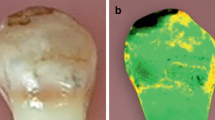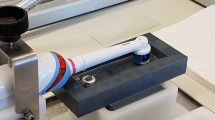Abstract
Purpose
Fluoride-containing adhesives for enamel sealing are commonly used for the prevention of white spot lesions during fixed orthodontic treatment. Thus, we examined whether enamel sealing with L.E.D. ProSeal® (Reliance Orthodontic Products Inc., Itasca, IL, USA) before bracket bonding increases the rate of bond failure during orthodontic treatment.
Methods
In 20 adolescents (11–16 years, 10 male/10 female) at the start of fixed therapy, self-ligating SmartClip™SL3 metal brackets (3M Unitek, Monovia, CA, USA) were bonded to cleaned and conditioned (40% H3PO4, 30 s) buccal enamel surfaces of all permanent teeth except molars using Transbond™ XT (3M Unitek). In a split-mouth design, either L.E.D. ProSeal® (1st/3rd quadrant) or Clinpro™ XT Varnish (2nd/4th quadrant; 3M Unitek) was applied to enamel surfaces before (ProSeal®) or after (Clinpro™ XT Varnish) bracket bonding (200 teeth each; light curing: 20 s, Ortholux™ Luminous, 3M Unitek). Cumulative bond failure as total number of teeth with bracket detachment since start of therapy was documented every 3 months for a total of 12 months.
Results
Cumulative bond failure was higher for enamel sealing before bonding from 6 months onward reaching significance at 12 months (34/200) compared to sealing after bonding (24/200): p = 0.038; Cramér’s V = 0.488; odds ratio (OR) = 1.5; relative risk (RR) = 1.4. The higher loss rate was limited to the lower arch, but evident within 3 months reaching significance at 9 and 12 months (p = 0.019/0.011, V = 0.636/0.630; OR = 1.7/1.75, RR = 1.5/1.6). In general, cumulative bond failure at 12 months was higher in the lower arch, but this was only significant for teeth sealed before bonding (p = 0.001, V = 0.303, OR = 3.4, RR = 2.8).
Conclusions
Enamel sealing with L.E.D. ProSeal® should be performed after bracket bonding to prevent increased bond failure and bracket loss in the lower dental arch.
Zusammenfassung
Zielsetzung
Eine Schmelzversiegelung mittels fluoridhaltiger Adhäsive zur Vermeidung von White-Spot-Läsionen hat in der festsitzenden kieferorthopädischen Therapie eine weite Verbreitung gefunden. In dieser Studie wurde untersucht, ob eine Versiegelung mittels L.E.D. ProSeal® (Reliance Orthodontic Products Inc., Itasca/IL, USA) vor dem adhäsiven Kleben von Brackets die Bracketverlustrate während der kieferorthopädischen Behandlung erhöht.
Methoden
Bei 20 jugendlichen Patienten (11–16 Jahre, 10 m., 10 w.) wurden zu Beginn einer festsitzenden Therapie selbstligierende SmartClip™-SL3-Metallbrackets (3M Unitek, Monovia/CA, USA) auf die gereinigten und konditionierten (40% H3PO4, 30 s) bukkalen Schmelzoberflächen aller bleibenden Zähne mit Ausnahme der Molaren adhäsiv geklebt (Transbond™ XT, 3M Unitek). In einem Split-Mouth-Design erfolgte eine Schmelzversiegelung mittels entweder L.E.D. ProSeal® (1./3. Quadrant) oder Clinpro™XT-Varnish (2./4. Quadrant; 3M Unitek) vor (ProSeal®) oder nach (Clinpro™XT) dem Kleben der Brackets (200 Zähne, Lichthärtung 20 s mit Ortholux™ Luminous, 3M Unitek). Die kumulative Bracketverlustrate als Gesamtzahl der Zähne mit Bracketablösung seit Therapiebeginn wurde alle 3 Monate für insgesamt 12 Monate dokumentiert.
Ergebnisse
Die kumulative Bracketverlustrate war für die Schmelzversiegelung vor gegenüber nach dem Kleben der Brackets ab 6 Monaten erhöht mit Signifikanz nach 12 Monaten (34/200 vs. 24/200): p = 0,038; Cramérs V = 0,488; OR (Odds Ratio) = 1,5; RR (relatives Risiko) = 1,4. Die höhere Verlustrate war auf den unteren Zahnbogen begrenzt, trat jedoch innerhalb von 3 Monaten auf und erreichte nach 9 sowie nach 12 Monaten Signifikanz (p = 0,019/0,011, V = 0,636/0,630; OR = 1,7/1,75, RR = 1,5/1,6). Im Allgemeinen war die kumulative Bracketverlustrate nach 12 Monaten im unteren Zahnbogen höher; signifikant war dies jedoch nur für Zähne, die vor dem Kleben der Brackets versiegelt worden waren (p = 0,001, V = 0,303, OR = 3,4, RR = 2,8).
Schlussfolgerungen
Eine Schmelzversiegelung mittels L.E.D. ProSeal® sollte nach dem Kleben von Brackets durchgeführt werden, um eine erhöhte Versagens- und Bracketverlustrate im unteren Zahnbogen zu vermeiden.

Similar content being viewed by others
References
Al Mulla AH, Kharsa SA, Birkhed D (2010) Modified fluoride toothpaste technique reduces caries in orthodontic patients. A longitudinal, randomized clinical trial. Am J Orthod Dentofacial Orthop 138:285–291
Arici S, Alkan A, Arici N (2007) Comparison of different toothbrushing protocols in poor-toothbrushing orthodontic patients. Eur J Orthod 29:488–492
Benson PE, Parkin N, Dyer F et al (2013) Fluorides for the prevention of early tooth decay (demineralised white lesions) during fixed brace treatment. Cochrane Database Syst Rev. https://doi.org/10.1002/14651858.CD003809.pub3
Bishara SE, Oonsombat C, Soliman MMA et al (2005) Effects of using a new protective sealant on the bond strength of orthodontic brackets. Angle Orthod 75:243–246
Cal-Neto JP, Miguel JAM, Zanella E (2006) Effect of a self-etching primer on shear bond strength of adhesive precoated brackets in vivo. Angle Orthod 76:127–131
Chadwick BL, Roy J, Knox J et al (2005) The effect of topical fluorides on decalcification in patients with fixed orthodontic appliances. A systematic review. Am J Orthod Dentofacial Orthop 128:601–606 (quiz 670)
Chang HS, Walsh LJ, Freer TJ (1999) The effect of orthodontic treatment on salivary flow, pH, buffer capacity, and levels of mutans streptococci and lactobacilli. Aust Orthod J 15:229–234
Chestnutt IG, Playle R, Hutchings S et al (2017) Fissure seal or fluoride varnish? A randomized trial of relative effectiveness. J Dent Res 96:754–761
El Bokle D, Munir H (2008) An in vitro study of the effect of Pro Seal varnish on the shear bond strength of orthodontic brackets. World J Orthod 9:141–146
Frazier MC, Southard TE, Doster PM (1996) Prevention of enamel demineralization during orthodontic treatment. An in vitro study using pit and fissure sealants. Am J Orthod Dentofacial Orthop 110:459–465
Gorelick L, Geiger AM, Gwinnett AJ (1982) Incidence of white spot formation after bonding and banding. Am J Orthod 81:93–98
Hajrassie MKA, Khier SE (2007) In-vivo and in-vitro comparison of bond strengths of orthodontic brackets bonded to enamel and debonded at various times. Am J Orthod Dentofacial Orthop 131:384–390
Heymann GC, Grauer D (2013) A contemporary review of white spot lesions in orthodontics. J Esthet Restor Dent 25:85–95
Hujoel PP, Moulton LH (1988) Evaluation of test statistics in split-mouth clinical trials. J Periodont Res 23:378–380
Kirschneck C, Christl J‑J, Reicheneder C et al (2016) Efficacy of fluoride varnish for preventing white spot lesions and gingivitis during orthodontic treatment with fixed appliances—a prospective randomized controlled trial. Clin Oral Investig 20:2371–2378
Knösel M, Forslund L, Jung K et al (2012) Efficacy of different strategies in protecting enamel against demineralization during fixed orthodontic treatment. J Orofac Orthop 73:194–203
Korbmacher-Steiner HM, Schilling AF, Huck LG et al (2013) Laboratory evaluation of toothbrush/toothpaste abrasion resistance after smooth enamel surface sealing. Clin Oral Investig 17:765–774
Linklater RA, Gordon PH (2003) Bond failure patterns in vivo. Am J Orthod Dentofacial Orthop 123:534–539
Lowder PD, Foley T, Banting DW (2008) Bond strength of 4 orthodontic adhesives used with a caries-protective resin sealant. Am J Orthod Dentofacial Orthop 134:291–295
Migliorati M, Isaia L, Cassaro A et al (2015) Efficacy of professional hygiene and prophylaxis on preventing plaque increase in orthodontic patients with multibracket appliances. A systematic review. Eur J Orthod 37:297–307
Millett DT, Hallgren A, Cattanach D et al (1998) A 5‑year clinical review of bond failure with a light-cured resin adhesive. Angle Orthod 68:351–356
Murfitt PG, Quick AN, Swain MV et al (2006) A randomised clinical trial to investigate bond failure rates using a self-etching primer. Eur J Orthod 28:444–449
Ogaard B (1989) Prevalence of white spot lesions in 19-year-olds. A study on untreated and orthodontically treated persons 5 years after treatment. Am J Orthod Dentofacial Orthop 96:423–427
O’Reilly MT, de Viñas JJ, Hatch JP (2013) Effectiveness of a sealant compared with no sealant in preventing enamel demineralization in patients with fixed orthodontic appliances. A prospective clinical trial. Am J Orthod Dentofacial Orthop 143:837–844
Paschos E, Geiger F‑J, Malyk Y et al (2016) Efficacy of four preventive measures against enamel demineralization at the bracket periphery-comparison of microhardness and confocal laser microscopy analysis. Clin Oral Investig 20:1355–1366
Pickett KL, Sadowsky PL, Jacobson A et al (2001) Orthodontic in vivo bond strength. Comparison with in vitro results. Angle Orthod 71:141–148
Reicheneder C, Hofrichter B, Faltermeier A et al (2014) Shear bond strength of different retainer wires and bonding adhesives in consideration of the pretreatment process. Head Face Med 10:51
Rosenbach G, Cal-Neto JP, Oliveira SR et al (2007) Effect of enamel etching on tensile bond strength of brackets bonded in vivo with a resin-reinforced glass ionomer cement. Angle Orthod 77:113–116
Stecksén-Blicks C, Renfors G, Oscarson ND et al (2007) Caries-preventive effectiveness of a fluoride varnish. A randomized controlled trial in adolescents with fixed orthodontic appliances. Caries Res 41:455–459
Tarvade SM, Deshmukh AA, Daokar SG (2014) Evaluation of bond strength. An in vitro study using pro seal. J Int Oral Health 6:1–3
Underwood ML, Rawls HR, Zimmerman BF (1989) Clinical evaluation of a fluoride-exchanging resin as an orthodontic adhesive. Am J Orthod Dentofacial Orthop 96:93–99
van der Veen MH, Attin R, Schwestka-Polly R et al (2010) Caries outcomes after orthodontic treatment with fixed appliances. Do lingual brackets make a difference? Eur J Oral Sci 118:298–303
Varlik SK, Demirbaş E (2009) Effect of light-cured filled sealant on the bond failure rate of orthodontic brackets in vivo. Am J Orthod Dentofacial Orthop 135: 144.e1– 144.e4 (discussion 144–5)
Varlik SK, Ulusoy C (2009) Effect of light-cured filled sealant on shear bond strength of metal and ceramic brackets bonded with a resin-modified glass ionomer cement. Am J Orthod Dentofacial Orthop 135:194–198
Wenderoth CJ, Weinstein M, Borislow AJ (1999) Effectiveness of a fluoride-releasing sealant in reducing decalcification during orthodontic treatment. Am J Orthod Dentofacial Orthop 116:629–634
Whittaker DK (1982) Structural variations in the surface zone of human tooth enamel observed by scanning electron microscopy. Arch Oral Biol 27:383–392
Zachrisson BJ (1977) A posttreatment evaluation of direct bonding in orthodontics. Am J Orthod 71:173–189
Zachrisson BU, Heimgård E, Ruyter IE et al (1979) Problems with sealants for bracket bonding. Am J Orthod 75:641–649
Zingler S, Pritsch M, Wrede DJ et al (2014) A randomized clinical trial comparing the impact of different oral hygiene protocols and sealant applications on plaque, gingival, and caries index scores. Eur J Orthod 36:150–163
Acknowledgements
This work was awarded with the Best Poster Award (Parallel Symposium) at the 90th Scientific Annual Meeting of the German Orthodontic Society in Bonn, 2017.
Author information
Authors and Affiliations
Corresponding author
Ethics declarations
Conflict of interest
C. Kirschneck, C. Rohn, P. Proff and C. Reicheneder declare that they have no competing interests.
Ethical standards
All procedures performed were in accordance with the ethical standards of the institutional ethics committee and the 1964 Helsinki declaration and its later amendments. Informed consent was obtained from all individual participants included in the study and in addition, if underage, from their legal guardians.
Rights and permissions
About this article
Cite this article
Kirschneck, C., Rohn, C., Proff, P. et al. Influence of enamel sealing with a light-cured filled sealant before bracket bonding on the bond failure rate during fixed orthodontic therapy. J Orofac Orthop 80, 136–143 (2019). https://doi.org/10.1007/s00056-019-00174-w
Received:
Accepted:
Published:
Issue Date:
DOI: https://doi.org/10.1007/s00056-019-00174-w




